The Great Patriotic War
- Thread starter loki100
- Start date
-
We have updated our Community Code of Conduct. Please read through the new rules for the forum that are an integral part of Paradox Interactive’s User Agreement.
You are using an out of date browser. It may not display this or other websites correctly.
You should upgrade or use an alternative browser.
You should upgrade or use an alternative browser.
As Comrade Stuyvesant says, that would be defeatist talk. All the peoples' newspapers agree that the motherland's armed forces are the envy of the world.
I found myself chuckling at the description of 'leg infantry', and I'm not too sure why... My knowledge of HoI3 is far from exemplary, but things look a bit dodgy with the lack of armoured divisions you currently have.
you've been reading too many CK AARs
Germans in the British Isles... At first thought, I'd say that ups the difficulty for the Motherland, but that would be defeatist talk, showing a disturbing lack of confidence in Comrade Stalin. So, instead... Let's call it a great opportunity to further expand socialism (across the Channel!) in the near future.
Just build a lot of two-brigade divs of militia to man the line.
As Comrade Stuyvesant says, that would be defeatist talk. All the peoples' newspapers agree that the motherland's armed forces are the envy of the world.
well it does mean the Germans have nothing else to do with their army except maybe invade Canada, so it does rather simplify things, esp as the USA is staying resolutely neutral, if pro-allied. But yes, sighs, looks like its down to the Red Army to liberate Europe again.
Now, as befits such as wise commentator
I also have a lot of ports and some rather vulnerable borders in and around Central Asia and for the moment a mix of garissons and militia may just be whats needed.
Doctrine and Equipment Sept 39-June 1941
Introduction
This section covers the equipment and doctrine of the bulk of the RKKA (Raboche-Krest'yanskaya Krasnaya Armiya, the Workers’–Peasants’ Red Army). The next section looks at the development of the mechanised forces in detail. At the core, the mission of the RKKA was simplicity itself: to defend the Soviet Union.
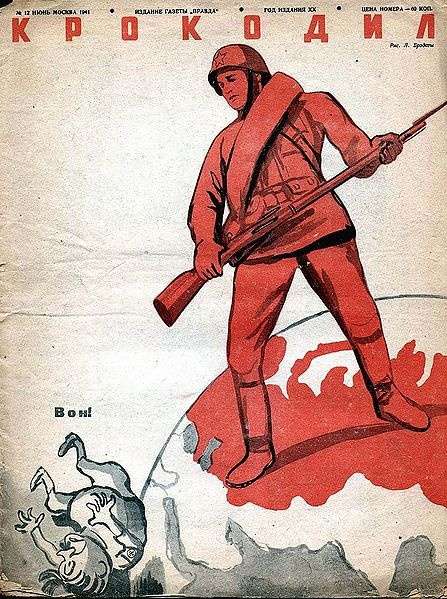
(poster reads: Go Away)
If, in July 1940, the Red Army was too small given the threat from both the West and the East, that, given time, was something that could be corrected. More importantly did it have the equipment, doctrine and organisation needed for modern warfare? Wrong choices in this respect were harder to correct.
One major problem was of equipment shortages, in particular of actually producing and issuing modern equipment once it was developed. At both Khalkin-Gol and in Finland Soviet infantrymen mostly fought with 1918 rifles, in no small part due to Kulik’s[1] decision to slow production of semi-automatic weapons on the grounds there were only ‘fit for policemen’. Thus it was not till January 1941 that the first round of new equipment was delivered, with the goal of improving the defensive resilience of the rifle divisions:
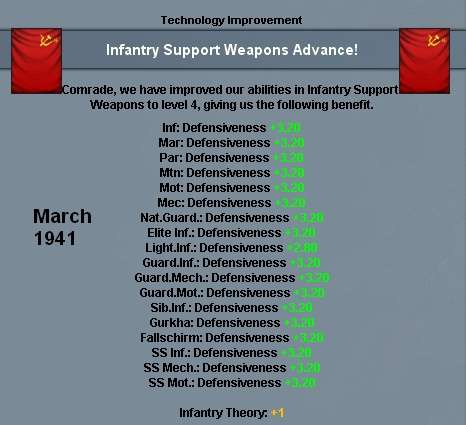
The Military Debate
However, the main problem that faced Soviet military planners in this period was how to deal with Tukhachevsky’s insights. Effectively the stress on turning the opposition’s flanks, moving deep into their rear and, if needed, gaining this mobility by first using shock tactics (and attacking in echelon) were all borne out in practice. The problem was that none of the doctrine developed from the end of the Civil War to the mid-1930s could be officially referred to. Nothing they observed in the German attacks on Poland, France or the UK invalidated those theories. Equally they had been vindicated in the Soviet border skirmishes with Japan and Finland.
A further problem was specifically the idea there was a particularly socialist model of warfare, that in turn led, some in the leadership to claim that 1 Soviet division could defend against 2 German[2]. This was to reach its full extent in the post-war era with Stalin’s ‘5 permanently operating forces’. However, it was present in all the military debates since 1917. In effect, did the character of the Soviet state “determine the character of the construction of the country's armed forces, the methods of combat training for troops and command personnel” as Frunze had claimed in the early 1920s in opposition to Trotsky’s views. In part there was some sense to this, the USSR was unique in many ways and the military traditions it had inherited and then developed in the Civil War were different to those prevalent in the West. Many Soviet commanders had served in the First World War, as well as the Civil War, and unlike their western equivalents core to their experience was mobile rather than positional warfare.
In consequence the Red Army had a theory, whose authors it could not acknowledge, and a mythical past which precluded the sort of criticism necessary for the perfection of theory. Real war in Mongolia, Poland, Finland, and France cracked the myth, allowing needed reforms prior to the German invasion. However, the boundaries of the myths were harshly policed and, as we shall see, this learning, in terms of training, equipment and operational skills came almost too late to save the USSR.
Developing the Solutions
One solution was to rebuild, slowly, the officer cadre of the RKKA after the losses in the purges. This alone, it was hoped, would diminish the delays suffered by combat formations in the Finnish war and assist in developing greater flexibility on the battlefield.
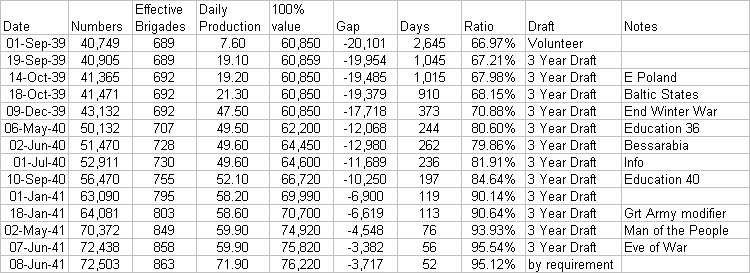
(the 'notes' column shows the various doctrinal and other changes that affected the daily production of officers, by the eve of war, the USSR was only 52 days from a full officer complement).
Second, given the backlog of equipment upgrades most of the effort was allocated to doctrinal improvements.
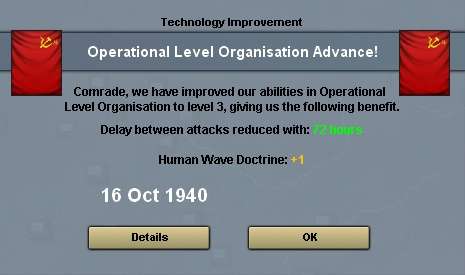
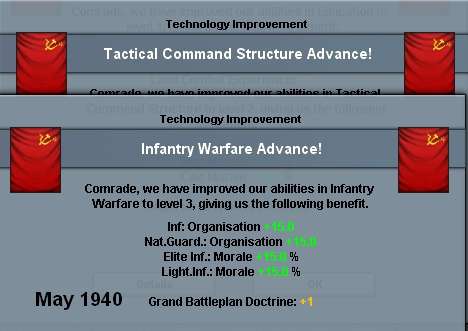

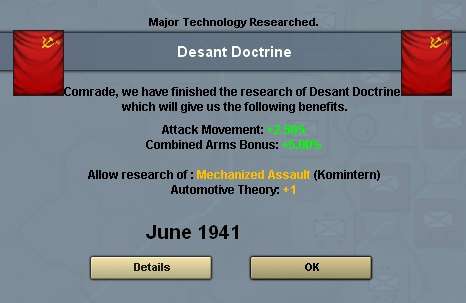
These advances in the main sought to improve the speed of combat operations, in particular to reduce the post-combat delays that had been such a problem in Finland.
Third, was to ensure that the logistical support and supply chains functioned as effectively as possible:
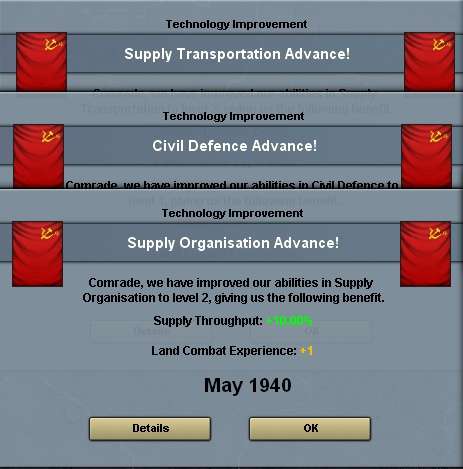

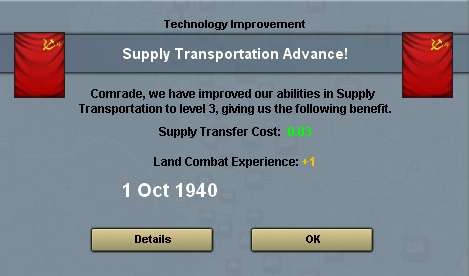
Fourth, more specialist forces were developed. This included more specialist artillery and anti-tank formations and the introduction of katyusha rocket brigades. These new formations were mostly allocated to the second echelon rifle divisions, the intention was that the counterblow to any invasion would be crushing:

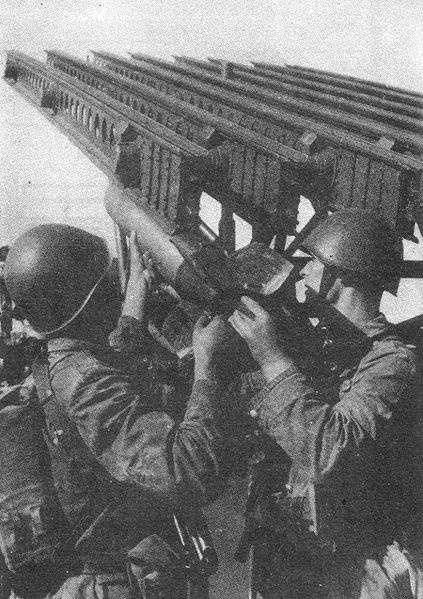
(Katyushas were maybe not the most effective of weapons but the impact on German morale was substantial)
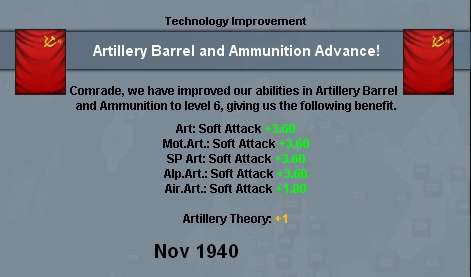
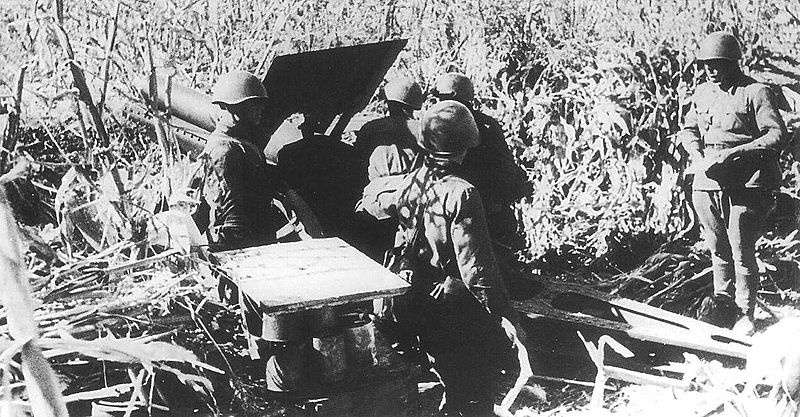
Finally, a small number of specialist forces was created. This saw the retraining of some rifle divisions to provide a larger paratroop force (held as a STAVKA reserve at Moscow)
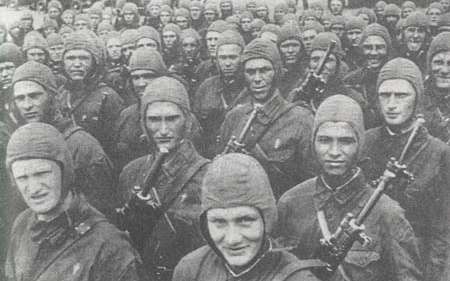
and a marine division (deployed at Sevastopol).
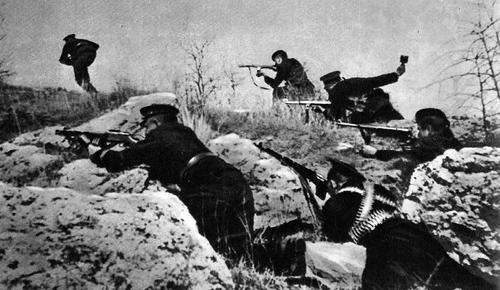
[1] One of Stalin's cronies, had a thing about horses as well. Never clear why Paradox keep him as #3 skill general.
[2] Yep, Kulik again and Budenny
Introduction
This section covers the equipment and doctrine of the bulk of the RKKA (Raboche-Krest'yanskaya Krasnaya Armiya, the Workers’–Peasants’ Red Army). The next section looks at the development of the mechanised forces in detail. At the core, the mission of the RKKA was simplicity itself: to defend the Soviet Union.

(poster reads: Go Away)
If, in July 1940, the Red Army was too small given the threat from both the West and the East, that, given time, was something that could be corrected. More importantly did it have the equipment, doctrine and organisation needed for modern warfare? Wrong choices in this respect were harder to correct.
One major problem was of equipment shortages, in particular of actually producing and issuing modern equipment once it was developed. At both Khalkin-Gol and in Finland Soviet infantrymen mostly fought with 1918 rifles, in no small part due to Kulik’s[1] decision to slow production of semi-automatic weapons on the grounds there were only ‘fit for policemen’. Thus it was not till January 1941 that the first round of new equipment was delivered, with the goal of improving the defensive resilience of the rifle divisions:

The Military Debate
However, the main problem that faced Soviet military planners in this period was how to deal with Tukhachevsky’s insights. Effectively the stress on turning the opposition’s flanks, moving deep into their rear and, if needed, gaining this mobility by first using shock tactics (and attacking in echelon) were all borne out in practice. The problem was that none of the doctrine developed from the end of the Civil War to the mid-1930s could be officially referred to. Nothing they observed in the German attacks on Poland, France or the UK invalidated those theories. Equally they had been vindicated in the Soviet border skirmishes with Japan and Finland.
A further problem was specifically the idea there was a particularly socialist model of warfare, that in turn led, some in the leadership to claim that 1 Soviet division could defend against 2 German[2]. This was to reach its full extent in the post-war era with Stalin’s ‘5 permanently operating forces’. However, it was present in all the military debates since 1917. In effect, did the character of the Soviet state “determine the character of the construction of the country's armed forces, the methods of combat training for troops and command personnel” as Frunze had claimed in the early 1920s in opposition to Trotsky’s views. In part there was some sense to this, the USSR was unique in many ways and the military traditions it had inherited and then developed in the Civil War were different to those prevalent in the West. Many Soviet commanders had served in the First World War, as well as the Civil War, and unlike their western equivalents core to their experience was mobile rather than positional warfare.
In consequence the Red Army had a theory, whose authors it could not acknowledge, and a mythical past which precluded the sort of criticism necessary for the perfection of theory. Real war in Mongolia, Poland, Finland, and France cracked the myth, allowing needed reforms prior to the German invasion. However, the boundaries of the myths were harshly policed and, as we shall see, this learning, in terms of training, equipment and operational skills came almost too late to save the USSR.
Developing the Solutions
One solution was to rebuild, slowly, the officer cadre of the RKKA after the losses in the purges. This alone, it was hoped, would diminish the delays suffered by combat formations in the Finnish war and assist in developing greater flexibility on the battlefield.

(the 'notes' column shows the various doctrinal and other changes that affected the daily production of officers, by the eve of war, the USSR was only 52 days from a full officer complement).
Second, given the backlog of equipment upgrades most of the effort was allocated to doctrinal improvements.




These advances in the main sought to improve the speed of combat operations, in particular to reduce the post-combat delays that had been such a problem in Finland.
Third, was to ensure that the logistical support and supply chains functioned as effectively as possible:



Fourth, more specialist forces were developed. This included more specialist artillery and anti-tank formations and the introduction of katyusha rocket brigades. These new formations were mostly allocated to the second echelon rifle divisions, the intention was that the counterblow to any invasion would be crushing:


(Katyushas were maybe not the most effective of weapons but the impact on German morale was substantial)


Finally, a small number of specialist forces was created. This saw the retraining of some rifle divisions to provide a larger paratroop force (held as a STAVKA reserve at Moscow)

and a marine division (deployed at Sevastopol).

[1] One of Stalin's cronies, had a thing about horses as well. Never clear why Paradox keep him as #3 skill general.
[2] Yep, Kulik again and Budenny
Last edited:
Building ~200 divisions that are made of two brigades of militia is what you need now most. They can defend for a short while, and if enough of them are in the same province, hamper the German attack. 
Or just to build a line of reserves that has enough depth 2-3 provinces behind the frontline.
Militia might be the worst, but yet it is, and it can man a province. Then later you can add to them artillery, rockets, NKVD, AA, engineers or tanks.
Can you also upgrade them to motorized troops?
Or just to build a line of reserves that has enough depth 2-3 provinces behind the frontline.
Militia might be the worst, but yet it is, and it can man a province. Then later you can add to them artillery, rockets, NKVD, AA, engineers or tanks.
Can you also upgrade them to motorized troops?
Things look quite dire considering the fact that Germany has been able to easily best Britain. Nonetheless hopefully winter, Russia's vast land, huge pool of resources and 'respect' for comrade Stalin can bring about victory. If I am not on the forum again from now, I've likely been taking in for interrogation due to defeatist talk in describing things as 'dire'...
Interesting psyche Kulik had, that he considered automatic weapons, capable of spewing dozens or hundreds of bullets per minute, as appropriate for police forces (meter maids with Shpagins?), but not for people whose main job description is to kill people (i.e. soldiers).
You have your work cut out for you - I look forward to seeing how Barbarossa develops this time. Last time you ran this particular experiment, you managed to stop the German advance pretty quickly, but then it took quite a while to fully exhaust them and go on the offensive yourself. Considering the fact that the Hun successfully overran Britain in this run-through, I am hopeful that the challenge will be even more fight-to-the-death style this time.
Edit: Does that poster read 'Krokodil'? Just curious, my grasp of Cyrillic is very limited.
You have your work cut out for you - I look forward to seeing how Barbarossa develops this time. Last time you ran this particular experiment, you managed to stop the German advance pretty quickly, but then it took quite a while to fully exhaust them and go on the offensive yourself. Considering the fact that the Hun successfully overran Britain in this run-through, I am hopeful that the challenge will be even more fight-to-the-death style this time.
Edit: Does that poster read 'Krokodil'? Just curious, my grasp of Cyrillic is very limited.
Last edited:
Building ~200 divisions that are made of two brigades of militia is what you need now most. They can defend for a short while, and if enough of them are in the same province, hamper the German attack.
Or just to build a line of reserves that has enough depth 2-3 provinces behind the frontline.
Militia might be the worst, but yet it is, and it can man a province. Then later you can add to them artillery, rockets, NKVD, AA, engineers or tanks.
Can you also upgrade them to motorized troops?
To answer the last bit, yes you can which makes them much less a dead end choice than in earlier versions of HOI. So I can use them as stop-gaps for a short period and then withdraw them and upgrade probably to rifle divs or to motorised rifle divs according to IC and need.
As to going all militia in the build up, I could have but want to try and build up a vaguely historic Soviet OOB, so I've stuck to rifle divisions as my unit of mass, and will, again relatively historically, raise DNO (militia) post invasion as an emergency force.
Interesting psyche Kulik had, that he considered automatic weapons, capable of spewing dozens or hundreds of bullets per minute, as appropriate for police forces (meter maids with Shpagins?), but not for people whose main job description is to kill people (i.e. soldiers).
well you've seen how awesome Soviet traffic police are unarmed
Things look quite dire considering the fact that Germany has been able to easily best Britain. Nonetheless hopefully winter, Russia's vast land, huge pool of resources and 'respect' for comrade Stalin can bring about victory. If I am not on the forum again from now, I've likely been taking in for interrogation due to defeatist talk in describing things as 'dire'...
You have your work cut out for you - I look forward to seeing how Barbarossa develops this time. Last time you ran this particular experiment, you managed to stop the German advance pretty quickly, but then it took quite a while to fully exhaust them and go on the offensive yourself. Considering the fact that the Hun successfully overran Britain in this run-through, I am hopeful that the challenge will be even more fight-to-the-death style this time.
I did some tests with the Barbarossa scenario at Theatre level and the Germans certainly threaten Moscow much more than they did in 1.3 (those were on hard as well), and the first winter played out more realistically leaving the Germans as a very definite threat in the second summer. Whilst I'd like to stop them on the borders etc, on the other hand, methinks the AAR is better for it being more of a threat this time around. Effectively this is going to be the whole of Europe vs the USSR, depends on how fast they can bring Finland and Yugoslavia into the axis.
Edit: Does that poster read 'Krokodil'? Just curious, my grasp of Cyrillic is very limited.
Yes its a front cover from, don't laugh, a Soviet official satirical magazine indeed called Krokodil. In the Brezhnev era, it became a sort of unofficially sanctioned source of dissident material, where, up to a point, articles about corruption and inefficiencies were aired. Can't imagine that being its editor was the safest job in the Stalinist period though.
The Development of Mobile Forces, Sept 39-June 41
Introduction
To Soviet military planners, armour was the key to modern warfare. Unfortunately, this view was not shared amongst all senior officers, and, equally, there were significant debates about how best to make use of the mobile forces available,
As late as January 1941, Kulik was arguing for the scrapping of the armoured forces and their replacement by 18,000 strong cavalry divisions. Others such as Zhukov saw the full benefits of armoured forces but still believed they would operate most effectively if dispersed amongst the regular formations.
However, there was agreement on several key areas. First the T-26s needed to be fully replaced, and the few BT7s upgraded to a 50mm main gun. This at least would match the Pzr III that was the mainstay of the German Panzer divisions in Poland and France. However, the BT7 had been designed for speed and the evidence, both from Finland and analysis of the German campaign in France, was that the armoured arm would have to break through enemy defences before they could exploit in depth.

(BT7 crossing a river at Khalkin-Gol, they were very effective against lightly armed opponents, but lacked the armour or main gun for modern tank warfare)
Doctrine
On the offensive, deep exploitation remained key to Soviet armoured doctrine. In effect, once the front was broken, the disruption would spread deeper and deeper into the enemy’s rear:
“If we break through to a depth of 8 km, we will paralyse the front to a depth of 30 km, if we break through to a depth of 30km, then we paralyse the front to a depth of 100km, if we break through 100km, the enemy loses control of the front”.
In the summer of 1941, the RKKA was learn the truth of those words. Not least as far too little attention was paid to the role of armour on the defense and the RKKA lacked the anti-tank weapons needed to deflect German armoured offensives.
If there was agreement as to the goal of mobile warfare, the question was how to achieve this.
Equipment
One solution was in terms of equipment. Thus, first the T-26s were replaced by the BT7 in all the tank formations.
Then, since the BT7 was essentially built for speed, it too was being phased out by the new T-34. On the eve of the German blow, the T-34 accounted for roughly one third of the Soviet medium tank establishment.


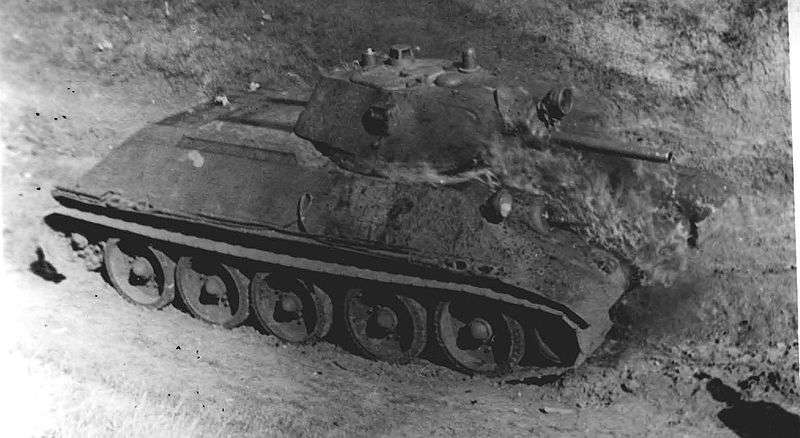
(a protype T-34 undergoing factory tests, in this case to determine if it was fire proof)
To improve the punch of the Tank Divisions, some were allocated additional organic artillery. The first versions were the zis-30, essentially an adapted tractor chasis, that first saw action at Velikiye Luki.
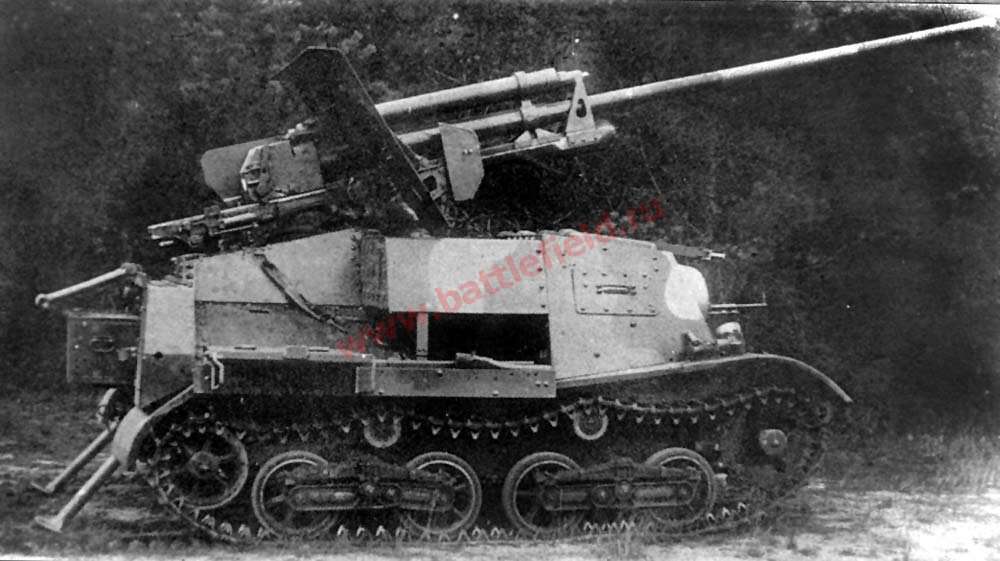
(zis-30, effectively a gun on top of a tractor, with flaps to provide stability)
To increase the number of armoured formations allocated to the infantry armies, small numbers of tank destroyers were produced, It was envisaged that in defensive actions these would enable infantry to hold their ground against German armoured attacks.
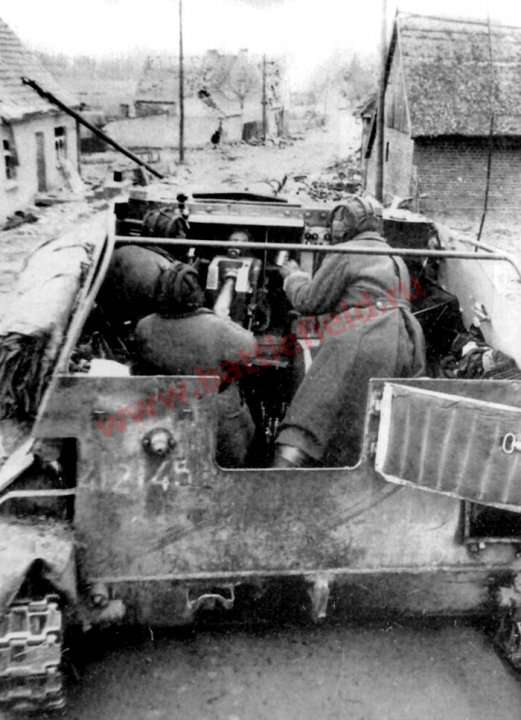
(SU-76 tank destroyer, as with the zis-30 this was a hastily designed solution and the crew were very vulnerable to enemy fire)
Finally came the question of whether or not specialist armour was needed for breakthrough operations. The role of such heavy tanks was not resolved before the German invasion, in part due to the inadequacies of the KV1 as a tank, in part due to the limited numbers (only 2 brigades were deployed by July 1941) and in part for doctrinal reasons.
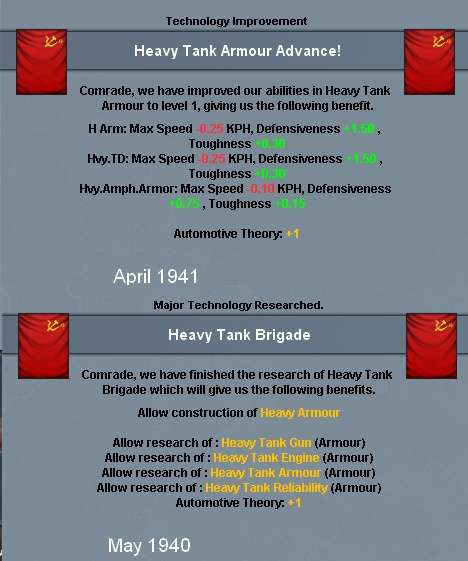
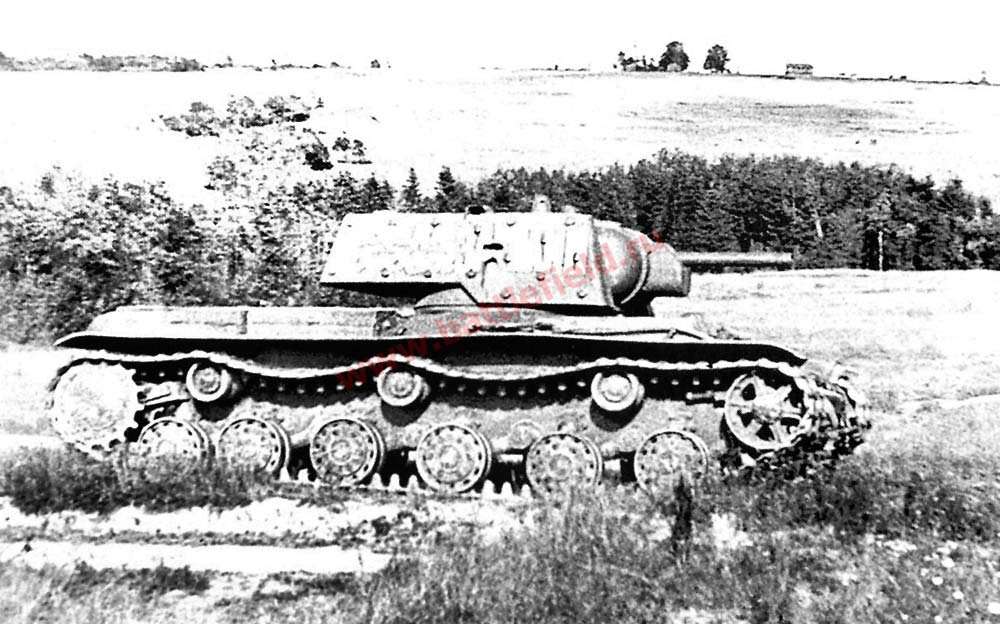
(KV1 in the Ukraine, Summer 1941)

(not all Soviet tank drivers were as careful as they should have been)
Organisation
The second solution was in terms of military organisation. Zhukov won part of the battle and the armoured formations were allocated to the main armies, however, they were concentrated into their own corps. The plan was to develop two related formations:
A tank corps of 2 tank divisions (2 med arm, 1 mot) and 1 mechanised division (1 light arm, 2 mot);
A mechanised corps of 1 tank division and 2 mechanised.
The problem was on the eve of war, the mechanised corps were often significantly below strength, in particular lacking in tank divisions.
By June 1941, the Soviet armoured forces were organised as:
West Front – 2 Tank Corps, 14 Mech Corps, 5 Mech Corps (1 div) & 3 Mech Corps (2 div);
South Front – 1 Tank Corps, 3 Tank Corps, 8 Mech Corps & 2 Mech Corps (1 div)
So of the Mech Corps only 2 (5 & 8) were at full establishment, giving the RKKA a total of 8 Tank Divisions split 3 in Bielorussia and 5 in the Western Ukraine.
The 11 mechanised divisions were based on 1 light armour brigade (at this stage mostly T-60s) and 2 of motorised infantry.
The T-60 light tank was seen as ideal in conditions of high mobility, but lacked the equipment to either break a defended zone or to deal with enemy armour. Unfortunately in the summer of 1941, such divisions often had to fend off German armoured blows, due to the lack of tank divisions in the Soviet army.
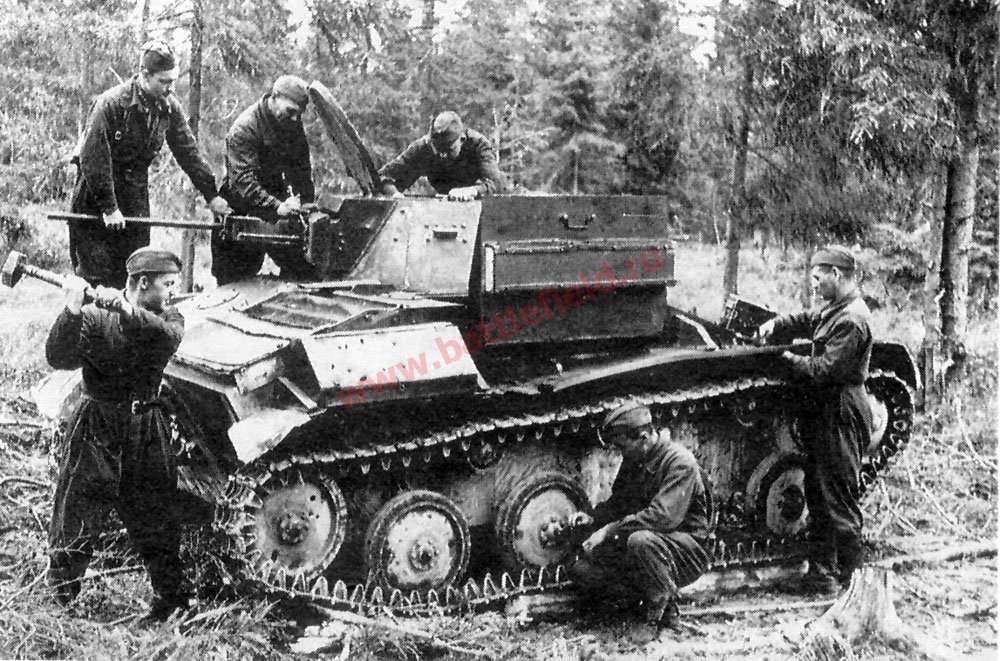
(the T-60 was effectively a better equipped armoured car)
A handful of motorised infantry divisions existed without light armour and these were mostly treated as conventional rifle divisions. In addition, 5 cavalry divisions were allocated to the reserve armies at Kharkov and Moscow.

(Soviet cavalry in the Ukraine, 1941)
Introduction
To Soviet military planners, armour was the key to modern warfare. Unfortunately, this view was not shared amongst all senior officers, and, equally, there were significant debates about how best to make use of the mobile forces available,
As late as January 1941, Kulik was arguing for the scrapping of the armoured forces and their replacement by 18,000 strong cavalry divisions. Others such as Zhukov saw the full benefits of armoured forces but still believed they would operate most effectively if dispersed amongst the regular formations.
However, there was agreement on several key areas. First the T-26s needed to be fully replaced, and the few BT7s upgraded to a 50mm main gun. This at least would match the Pzr III that was the mainstay of the German Panzer divisions in Poland and France. However, the BT7 had been designed for speed and the evidence, both from Finland and analysis of the German campaign in France, was that the armoured arm would have to break through enemy defences before they could exploit in depth.

(BT7 crossing a river at Khalkin-Gol, they were very effective against lightly armed opponents, but lacked the armour or main gun for modern tank warfare)
Doctrine
On the offensive, deep exploitation remained key to Soviet armoured doctrine. In effect, once the front was broken, the disruption would spread deeper and deeper into the enemy’s rear:
“If we break through to a depth of 8 km, we will paralyse the front to a depth of 30 km, if we break through to a depth of 30km, then we paralyse the front to a depth of 100km, if we break through 100km, the enemy loses control of the front”.
In the summer of 1941, the RKKA was learn the truth of those words. Not least as far too little attention was paid to the role of armour on the defense and the RKKA lacked the anti-tank weapons needed to deflect German armoured offensives.
If there was agreement as to the goal of mobile warfare, the question was how to achieve this.
Equipment
One solution was in terms of equipment. Thus, first the T-26s were replaced by the BT7 in all the tank formations.
Then, since the BT7 was essentially built for speed, it too was being phased out by the new T-34. On the eve of the German blow, the T-34 accounted for roughly one third of the Soviet medium tank establishment.



(a protype T-34 undergoing factory tests, in this case to determine if it was fire proof)
To improve the punch of the Tank Divisions, some were allocated additional organic artillery. The first versions were the zis-30, essentially an adapted tractor chasis, that first saw action at Velikiye Luki.

(zis-30, effectively a gun on top of a tractor, with flaps to provide stability)
To increase the number of armoured formations allocated to the infantry armies, small numbers of tank destroyers were produced, It was envisaged that in defensive actions these would enable infantry to hold their ground against German armoured attacks.

(SU-76 tank destroyer, as with the zis-30 this was a hastily designed solution and the crew were very vulnerable to enemy fire)
Finally came the question of whether or not specialist armour was needed for breakthrough operations. The role of such heavy tanks was not resolved before the German invasion, in part due to the inadequacies of the KV1 as a tank, in part due to the limited numbers (only 2 brigades were deployed by July 1941) and in part for doctrinal reasons.


(KV1 in the Ukraine, Summer 1941)

(not all Soviet tank drivers were as careful as they should have been)
Organisation
The second solution was in terms of military organisation. Zhukov won part of the battle and the armoured formations were allocated to the main armies, however, they were concentrated into their own corps. The plan was to develop two related formations:
A tank corps of 2 tank divisions (2 med arm, 1 mot) and 1 mechanised division (1 light arm, 2 mot);
A mechanised corps of 1 tank division and 2 mechanised.
The problem was on the eve of war, the mechanised corps were often significantly below strength, in particular lacking in tank divisions.
By June 1941, the Soviet armoured forces were organised as:
West Front – 2 Tank Corps, 14 Mech Corps, 5 Mech Corps (1 div) & 3 Mech Corps (2 div);
South Front – 1 Tank Corps, 3 Tank Corps, 8 Mech Corps & 2 Mech Corps (1 div)
So of the Mech Corps only 2 (5 & 8) were at full establishment, giving the RKKA a total of 8 Tank Divisions split 3 in Bielorussia and 5 in the Western Ukraine.
The 11 mechanised divisions were based on 1 light armour brigade (at this stage mostly T-60s) and 2 of motorised infantry.
The T-60 light tank was seen as ideal in conditions of high mobility, but lacked the equipment to either break a defended zone or to deal with enemy armour. Unfortunately in the summer of 1941, such divisions often had to fend off German armoured blows, due to the lack of tank divisions in the Soviet army.

(the T-60 was effectively a better equipped armoured car)
A handful of motorised infantry divisions existed without light armour and these were mostly treated as conventional rifle divisions. In addition, 5 cavalry divisions were allocated to the reserve armies at Kharkov and Moscow.

(Soviet cavalry in the Ukraine, 1941)
Last edited:
Thank you for this informative overview, but one big secret remains: What's with the VVS? Still a few squadrons SB2 bombers and I-15 fighters? Any (de)classified OOBs? 
One of the biggest strategic questions for me is allways on which models incl. doctrines and techs one had to concentrate. BTW, ASAIK you have a strong CAS bonus-tech in this mod (and very interessing but expensive new planes as well).
One of the biggest strategic questions for me is allways on which models incl. doctrines and techs one had to concentrate. BTW, ASAIK you have a strong CAS bonus-tech in this mod (and very interessing but expensive new planes as well).
Very informative stuff. Do you think yourself ready for Germany's attack? Or is it simply a case of enduring whilst still trying to improve on things, much as in real life?
well you've seen how awesome Soviet traffic police are unarmed
Just as I have almost managed to suppress that horrific image, you had to go and remind me, didn't you?
Good overview setting up the situation. Looks like you had a very clear idea of what you wanted, simply not nearly enough time (and IC?) to achieve it all.
Thank you for this informative overview, but one big secret remains: What's with the VVS? Still a few squadrons SB2 bombers and I-15 fighters? Any (de)classified OOBs?
Oddly the next post is on the VVS & RKKF (fleet), more on the VVS, so I'll be able to satisfy your curiousity on this point fairly soon.
One of the biggest strategic questions for me is allways on which models incl. doctrines and techs one had to concentrate. BTW, ASAIK you have a strong CAS bonus-tech in this mod (and very interessing but expensive new planes as well).
I've got a rough plan of a post on the VVS, one on industrial/research strategy, one on spies, one on china and then we're off to the main event.
A problem with the USSR is ideally you want a well balanced effort around both IC & leadership. If you start in 1936, broadly you can manage this but the later starts make it hard. With a degree of hindsight, the new luas give the German AI quite a taste for heavy armour, so I wish I'd really worked up my hard attack techs (AT, inf and armour) cause hvy tanks vs 1940 techs is a bit like dealing with the Terminator. I've not played far enough ahead to see if the consequence for the Germans is real supply problems, but at the moment the damn things are near unstoppable.
But more sensibly, you feel the shoe pinches everywhere, so I've prioritised clearing the upgrade backlog (why research something and not use it?) and all the techs around IC, research efficiency etc (long term gains) & sorting out the officer ratio (up from 67% to 95% is an awful lot of leadership).
Cavalry is useless when it comes to fighting, but it moves fast.
I must confess I like cavalry, but agree they are not there to hold the line. I'm holding them back to see if I can use them when the front gets stretched and I can slip them into the German rear to scoff supplies and cause mischief. If not, they'll do well for the war in China.
Very informative stuff. Do you think yourself ready for Germany's attack? Or is it simply a case of enduring whilst still trying to improve on things, much as in real life?
Good overview setting up the situation. Looks like you had a very clear idea of what you wanted, simply not nearly enough time (and IC?) to achieve it all.
In all truth no. I've had to put something like 35-40% of the IC to curing the upgrade backlog and thats really hampered the production of new units. Due to officer ratio and doctrinal lacks, as well as equipment research, I'm really behind the Germans. My guess is I need 3 rifle divs to hold off one german div in clear terrain and 2:1 with terrain advantages. At the start of Barbarossa, the strategic ratio is probably 1:1, so its a case of trying not to lose too many formations, but I've no illusions at my ability to actually hold ground. It depends on how close to winter Barbarossa actually starts.
Just as I have almost managed to suppress that horrific image, you had to go and remind me, didn't you?My eyes, my eyes.../
I really have to reuse that picture don't I
I really have to reuse that picture don't I? you'd be so disappointed, and everyone else so confused, otherwise

Yeah, yeah, guilty as charged.
By the way, what on earth is the soldier on the extreme left doing in that picture of the T-60 (yes, the man with the sledge hammer)?
Soviet engineering at it's finest!By the way, what on earth is the soldier on the extreme left doing in that picture of the T-60 (yes, the man with the sledge hammer)?
Oddly the next post is on the VVS & RKKF (fleet), more on the VVS, so I'll be able to satisfy your curiousity on this point fairly soon.
Great!
...just juvenile impatience, you awoke high expectations
By the way, what on earth is the soldier on the extreme left doing in that picture of the T-60 (yes, the man with the sledge hammer)?
Soviet engineering at it's finest!
Yep, think of it as the Proletarian version of 'we've lost the manual so lets try things at random till it works again', it works with VCRs and other electronic equipment so why not with a tank?
Great! ..., you awoke high expectations
and, for being so keen ... here it is:
The development of the air and naval forces to June 1941
The VVS (Voenno-Vozdushnye Sily, ie the Military Air Forces)
In this period, both the air and naval forces were seen as subsidiary arms of the RKKA. Practically, this meant the VVS was given two roles – protection of Soviet airspace (the primary role of the fighter squadrons) and support of RKKA operations. The fighter squadrons (PVO - Provito Vozdushnaya Oborona) were mostly allocated to geographic areas.
The VVS was seen by the STAVKA as one of the main successes of the short Finnish war. In particular the bombers had badly disrupted the Finnish defences and preyed on retreating Finnish formations. Thus, despite all the other demands, a reasonable amount of both research and industrial capacity was allocated to upgrading and expanding the VVS. By early June 1941, there were 43 squadrons:

The I-16 fighters and SB2 bombers that had served so well in Finland had mostly been replaced. The interceptor role, so crucial to Soviet air doctrine, was now performed by the LAGG-3.
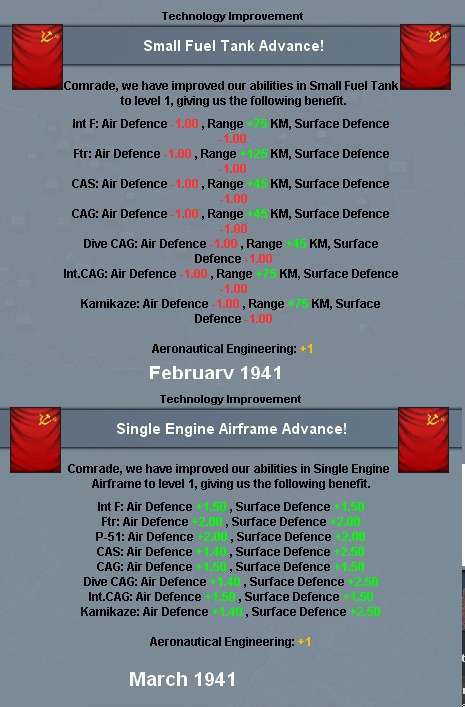
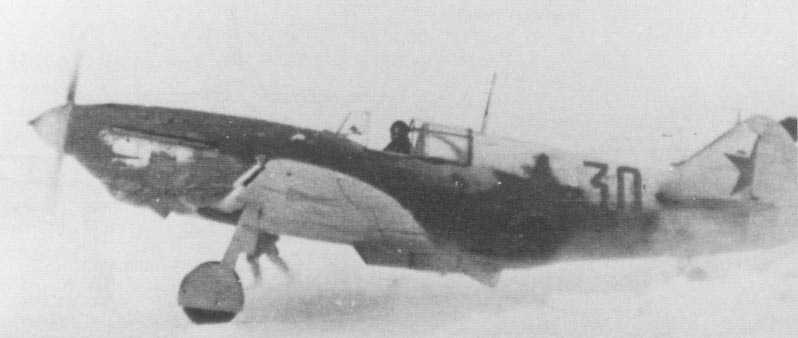
In addition some longer range Mig-3 fighters were deployed just after the German attack, with these designed initially to protect the vulnerable low level attack aircraft.
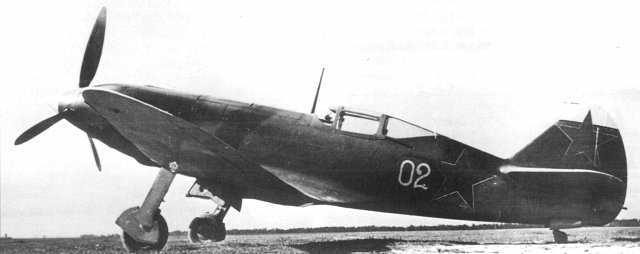
The bomber forces were now mostly composed of Pe-2 medium bombers (an upgrade of the SB-2).
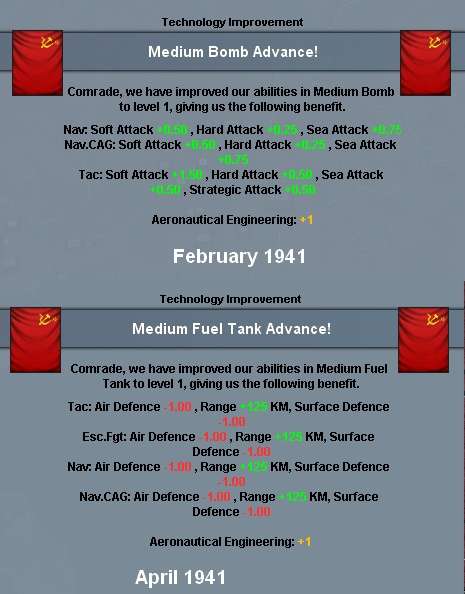


In addition there were a few of the new Il-2 (Sturmovik) ground attack aircraft. Unlike their German equivalents these were designed not as dive bombers but more as low level attack aircraft with heavily armoured nose and undercarriages.
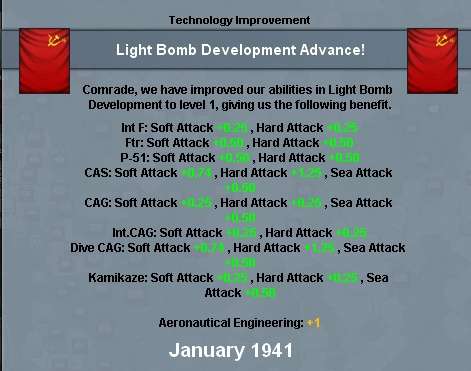
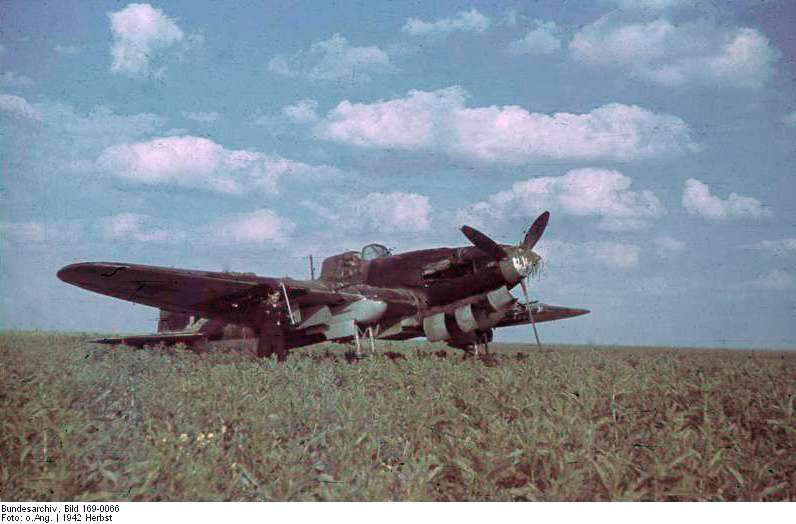
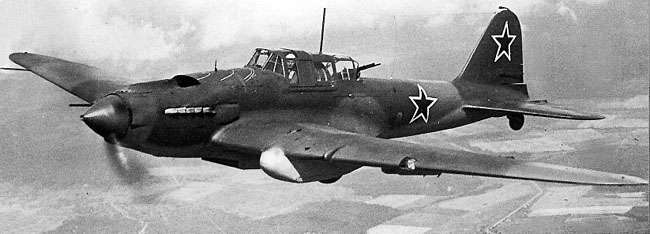
The problem was that in terms of equipment, these aircraft were roughly equivalent to their German opponents. Where the VVS badly lagged was in terms of doctrinal development, pilot and aircrew training. This was made worse by the decision in January 1940 to reduce training times for all new formations across the Soviet armed forces.
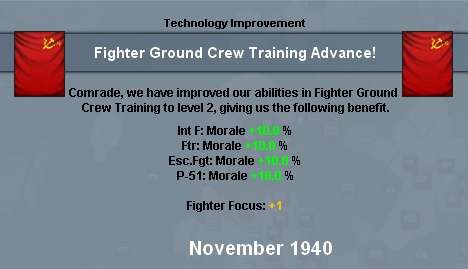
The 10 PVO groups were assigned 1 each to Leningrad and Moscow, 1 at Vladivostock and the rest divided up across the Western USSR. Of the 3 Pe-2 groups, one was held back at Moscow as a strategic reserve, the others were split one in Bielorussia, one in the Ukraine. The two Il-2 air groups were deployed at Minsk and Kiev respectively.
The RKKF (Raboche-Krest'yansky Krasny Flot, the Workers' and Peasants' Red Fleet [1])
Less attention was lavished on the RKKF. There was a small expansion in 1939-40 that saw the deployment of 2 modern (Schuka class) submarine squadrons, additional destroyers (allocated to the Northern Fleet) and a new Heavy Cruiser (allocated to the Far East Fleet). Against this was the decision in August 1939 to scrap 15 pre-WW1 submarine squadrons, so as to concentrate resources (especially leadership) on more modern equipment.

Stalin envisaged a larger surface navy that could operate against the enemies of the Soviet Union who were otherwise protected by oceans. In this period that was impractical and the surface fleet continued to rely on the three pre-WW1 battleships such as the Marat.

The relatively large submarine force was made up mostly (around 70%) of the early 1930 Leninets class with the balance the more modern Schuka. In the event of war, the performance of this part of the Soviet armed forces was a revelation, strangling axis supply lines and convoy routes in both the Baltic and Black Sea.
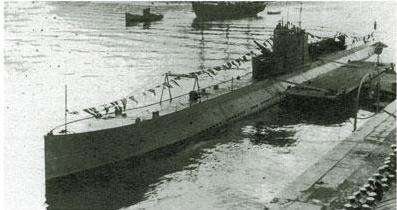
(Leninets class submarine)
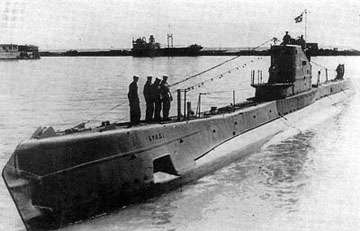
(Schuka class)
[1] renamed the VMF (Voyenno-Morskoy Flot) in 1946
The VVS (Voenno-Vozdushnye Sily, ie the Military Air Forces)
In this period, both the air and naval forces were seen as subsidiary arms of the RKKA. Practically, this meant the VVS was given two roles – protection of Soviet airspace (the primary role of the fighter squadrons) and support of RKKA operations. The fighter squadrons (PVO - Provito Vozdushnaya Oborona) were mostly allocated to geographic areas.
The VVS was seen by the STAVKA as one of the main successes of the short Finnish war. In particular the bombers had badly disrupted the Finnish defences and preyed on retreating Finnish formations. Thus, despite all the other demands, a reasonable amount of both research and industrial capacity was allocated to upgrading and expanding the VVS. By early June 1941, there were 43 squadrons:

The I-16 fighters and SB2 bombers that had served so well in Finland had mostly been replaced. The interceptor role, so crucial to Soviet air doctrine, was now performed by the LAGG-3.


In addition some longer range Mig-3 fighters were deployed just after the German attack, with these designed initially to protect the vulnerable low level attack aircraft.

The bomber forces were now mostly composed of Pe-2 medium bombers (an upgrade of the SB-2).



In addition there were a few of the new Il-2 (Sturmovik) ground attack aircraft. Unlike their German equivalents these were designed not as dive bombers but more as low level attack aircraft with heavily armoured nose and undercarriages.



The problem was that in terms of equipment, these aircraft were roughly equivalent to their German opponents. Where the VVS badly lagged was in terms of doctrinal development, pilot and aircrew training. This was made worse by the decision in January 1940 to reduce training times for all new formations across the Soviet armed forces.

The 10 PVO groups were assigned 1 each to Leningrad and Moscow, 1 at Vladivostock and the rest divided up across the Western USSR. Of the 3 Pe-2 groups, one was held back at Moscow as a strategic reserve, the others were split one in Bielorussia, one in the Ukraine. The two Il-2 air groups were deployed at Minsk and Kiev respectively.
The RKKF (Raboche-Krest'yansky Krasny Flot, the Workers' and Peasants' Red Fleet [1])
Less attention was lavished on the RKKF. There was a small expansion in 1939-40 that saw the deployment of 2 modern (Schuka class) submarine squadrons, additional destroyers (allocated to the Northern Fleet) and a new Heavy Cruiser (allocated to the Far East Fleet). Against this was the decision in August 1939 to scrap 15 pre-WW1 submarine squadrons, so as to concentrate resources (especially leadership) on more modern equipment.

Stalin envisaged a larger surface navy that could operate against the enemies of the Soviet Union who were otherwise protected by oceans. In this period that was impractical and the surface fleet continued to rely on the three pre-WW1 battleships such as the Marat.

The relatively large submarine force was made up mostly (around 70%) of the early 1930 Leninets class with the balance the more modern Schuka. In the event of war, the performance of this part of the Soviet armed forces was a revelation, strangling axis supply lines and convoy routes in both the Baltic and Black Sea.

(Leninets class submarine)

(Schuka class)
[1] renamed the VMF (Voyenno-Morskoy Flot) in 1946
... so I've stuck to rifle divisions as my unit of mass, and will, again relatively historically, raise DNO (militia) post invasion as an emergency force.
Liked your concept of recruiting some garrisons before, even as an emergency-built second-line-unit they could be valuable in the defense of strategic important cities and surrounding hexes. But they have to rely on tsaristic rifles, I'm afraid?

